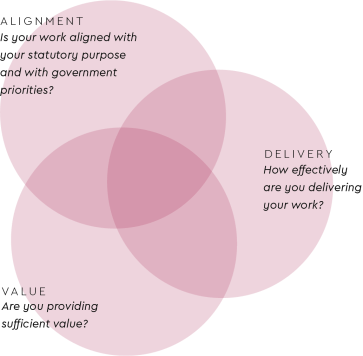Value for Money
Richard Tait, an Executive Director at MartinJenkins, delves into the importance of Value for Money reviews for our public sector. Richard highlights how they can be a crucial tool for making better use of resources and achieving effective results, particularly in a tough economic climate.

As expected, the focus and tone of Budget 2023 was around cost of living and responses to weather events.
The Reserve Bank’s response to the Budget appears to be a signal that the economy is beginning to cool, but cost of living pressures will remain high for many New Zealanders, even as the economy begins to regain its equilibrium.
In the midst of this tumultuous economic landscape that we’ve experienced over the last few years, ensuring value for money in the public sector has become even more important than normal. Significant expenditure on the COVID-19 response and now the upcoming focus on flood recovery are also imposing fiscal constraints on the government, with public spending being diverted into investing in infrastructure and resilience.
In this article, we set the scene for the importance of Value for Money reviews in the New Zealand public sector, highlighting how they are a tool to improve the utilisation of resources and produce effective results in the face of harder economic times. In our next article, we’ll share our experiences about what makes for a successful review of this kind.
“More than words”: Public agencies need to show they’re financially sustainable and delivering value
Ministers and the public rightly expect public resources to be used efficiently and effectively, and agencies must rise to the challenge by evaluating their practices, expenditures, and performance. By getting this right, they can build public trust, show they’re responsible stewards of taxpayer funds, and achieve best value in delivering public services.
Finance Minister Hon Grant Robertson has been clear about this. In a pre‑Budget speech to Wellington’s Chamber of Commerce on 11 May he said the public sector needs to continue to drive and get better at efficiency and prioritisation. He went on to say:
“I appreciate that this is the sort of thing that Ministers of Finance are supposed to say, and that regardless of political orientation, it is part of the job to want to see more efficiency, greater value for money and greater prioritisation among other agencies. But we have to take action to prove that it is more than words. … We owe that to New Zealanders as they are carefully considering their spending, and making trade-offs in their lives, that we do the same.”
It’s not just the current expenditure that attracts scrutiny. Any agency seeking more resources to fund its work will need to present a strong case for the investment, clearly explaining the potential return through the positive impact the additional funding would have. This could be in the form of improved services, better outcomes, or increased efficiency. The agency would also need to show it first sought to cover the cost through reprioritising its existing resources, before asking for more money.
The corollary of all this is that government agencies are under pressure to identify and eliminate low-value spending. They’re expected to look closely at their spending patterns and identify areas where resources are being misallocated or where low-value activities can be stopped. By identifying and removing that kind of low-value or misallocated expenditure, agencies can redirect resources towards activities that better serve the needs of the public.
Overseas governments are gearing up for better-quality evaluation of programmes
Aotearoa is not alone in the heightened scrutiny we are applying to effectiveness and efficiency in the public sector — overseas governments are making this a priority as well.
My colleague EeMun Chen wrote recently about the Australian federal government’s announcement in April that it is setting up a new central evaluation unit in the Treasury. The idea is to provide a centralised, whole-of-government approach to evaluating the effectiveness of federal programmes.
EeMun also talked about the new Evaluation Task Force set up in the UK as a joint Treasury–Cabinet Office unit after the 2020 Spending Review. The Task Force advises departments and drives improvements in how government programmes are evaluated, in order to provide the government with “confidence the money it spends is delivering better outcomes for the public, and delivers value for money”.
What is a Value for Money review?
Value for Money (VFM) reviews are nothing new — they have a longstanding history in New Zealand and other countries as a powerful tool for evaluating how effective and efficient a given government public-sector programme or agency is.
Like other types of organisational review, they shine the torch onto opportunities for improvement — in this case the balance between achieving an impact and the level of resource that goes into making that happen. VFM reviews highlight best practices and offer recommendations for action.
In Aotearoa the practice began in the 1980s as part of the country’s wider public-management reforms, aimed at improving fiscal responsibility and service delivery. The Treasury and the Office of the Auditor-General played significant roles in developing guidelines and methodologies for VFM reviews. They established a framework that’s still widely followed today, with adjustments to update the approach.
Value for Money reviews should be a routine check-up
The spectre of a review like this can feel as appealing as the prospect of a root canal. But done well it is more like getting a routine check-up: it turned out to be not that bad, you came away with instructions to floss daily and cut back on the pineapple lumps, and you got a shiny new filling that didn’t really hurt after all. As one Chief Executive said to us:
“Now I really understand my business. I’d been working in a world of assumptions.”
A VFM review allows your agency to take a good, open-minded look in the mirror and it can produce several important benefits that make it all worth it.
First, VFM reviews provide opportunities for greater efficiency. They enable agencies to identify inefficiencies or duplication, and any areas where resources can be better allocated. By streamlining their processes and improving how they utilise their resources, agencies can then achieve more with the resources they’ve already got, or they can reduce their costs.
The reviews can also lead to greater effectiveness. They assess the results agencies are achieving, identifying areas where the agency could have more impact and better meet the needs of the public. This ensures taxpayer funds are being directed towards activities that generate the desired results.
By subjecting strategy, policy, and operations to external scrutiny, VFM reviews also promote transparency and accountability in the public sector. They provide assurance to the public and to stakeholders in the relevant policy or service area that public funds are being used wisely and appropriately.
At the core of reviewing value for money are three questions
Here at MartinJenkins, we use a framework that’s aligned with best practice in the public sector and that poses three broad questions:
- Alignment — Is your work aligned with your mandate and purpose and with the priorities of the government of the day? As well as looking at those areas, we would consider the challenges, risks, and opportunities your agency is facing, now and in the future.
- Delivery — How well are you delivering your work? Areas explored include the effectiveness and cost effectiveness of your current approaches, and any opportunities for efficiencies. We would look at your decision making and whether your organisation has the right capabilities, now and for the future.
- Value — Are you providing sufficient value? Areas explored include the results you’ve achieved, your monitoring and reporting processes, how you’re measuring performance, and how you’re managing risk.
Every agency has its own unique operating environment, and so while that framework guides the lines of enquiry, this is not a tick-the-boxes kind of exercise.
It’s important to take the time to explore the real context, understand what’s making the organisation tick, and identify where the best leverage points are. This means using a combination of qualitative and quantitative methods to dig deeper beyond what may seem to be obvious problems and solutions.

See you again
We’ll see you again soon for the second part of this look at VFM reviews. There we’ll dig further into the detail of how your organisation can get the most out of them.